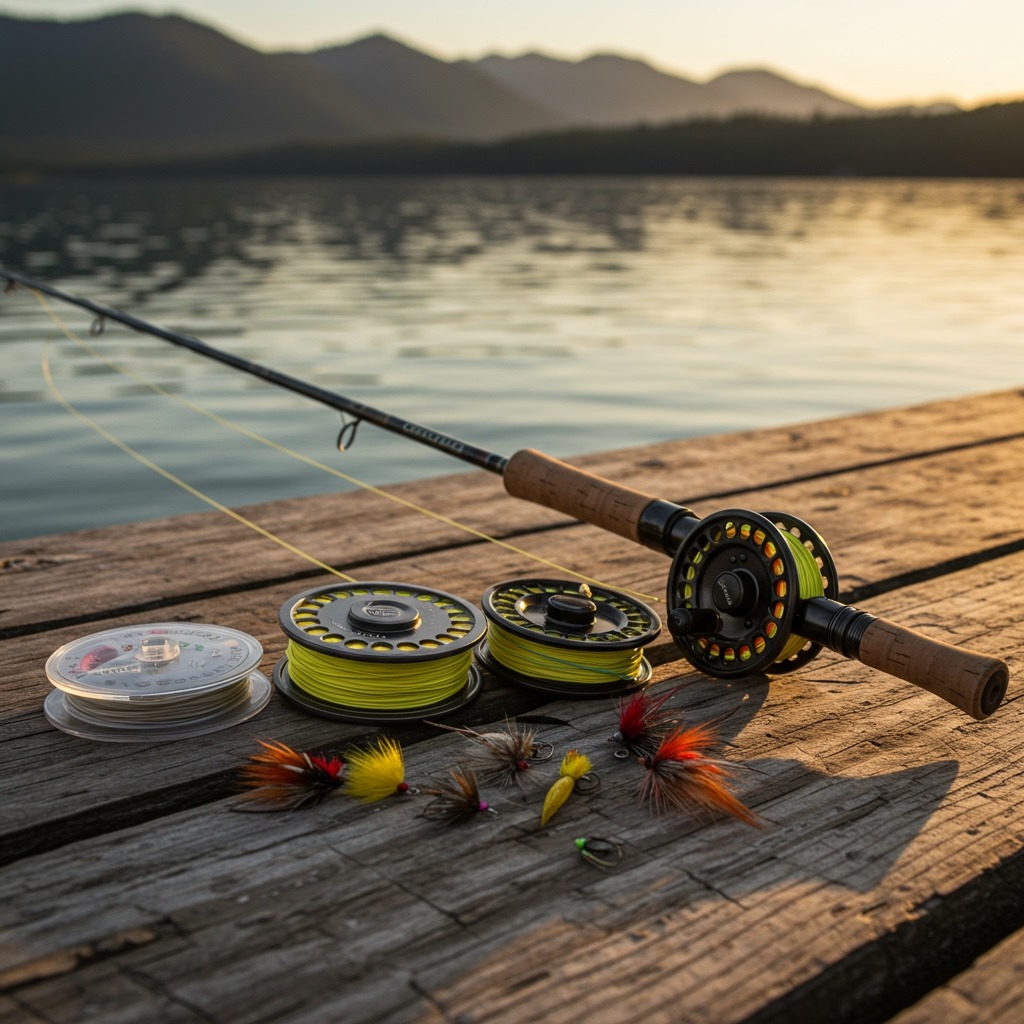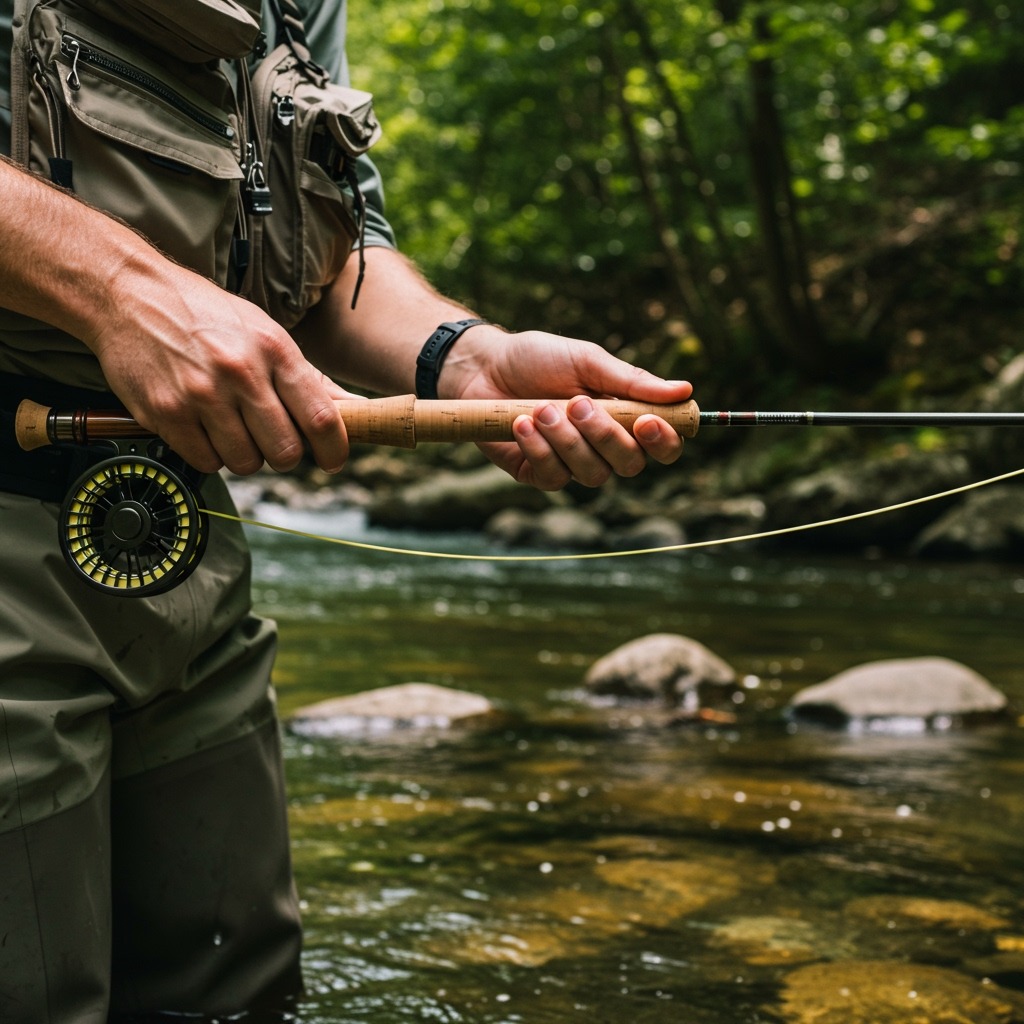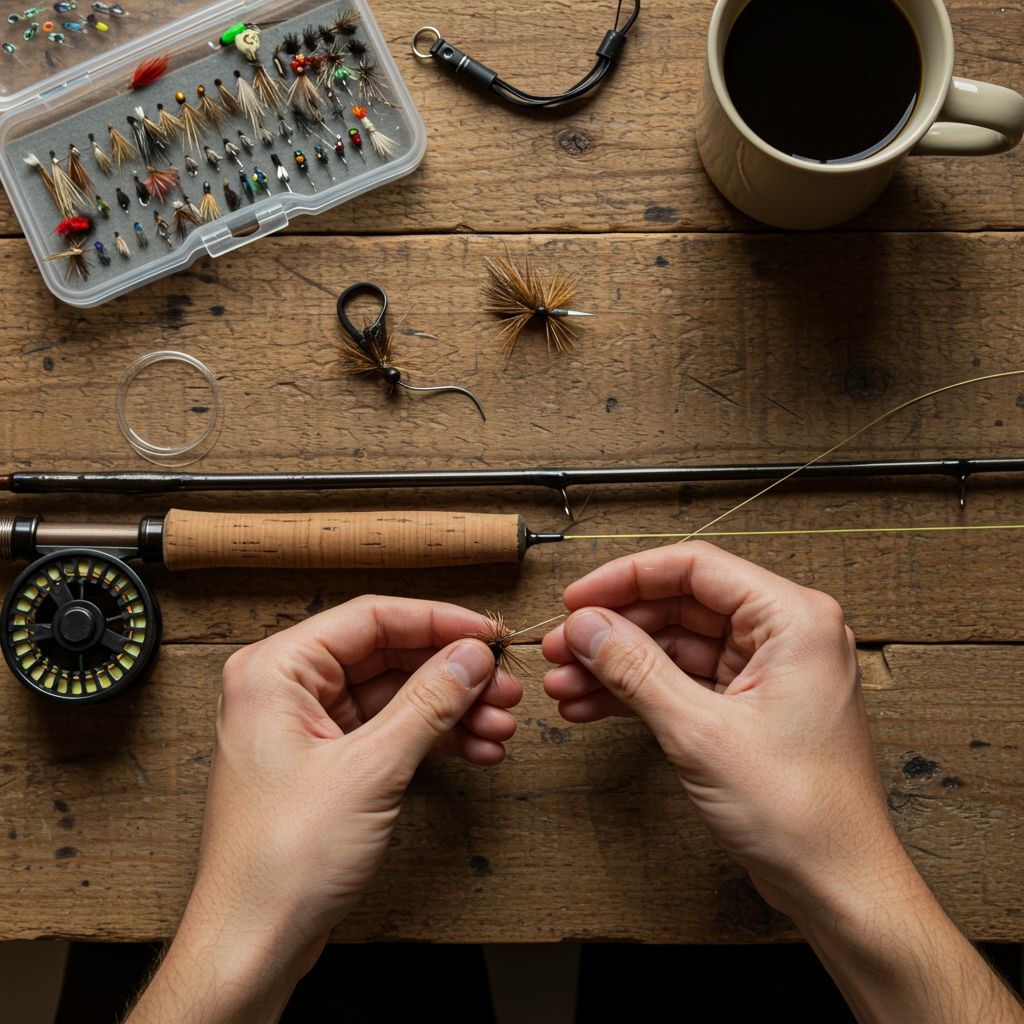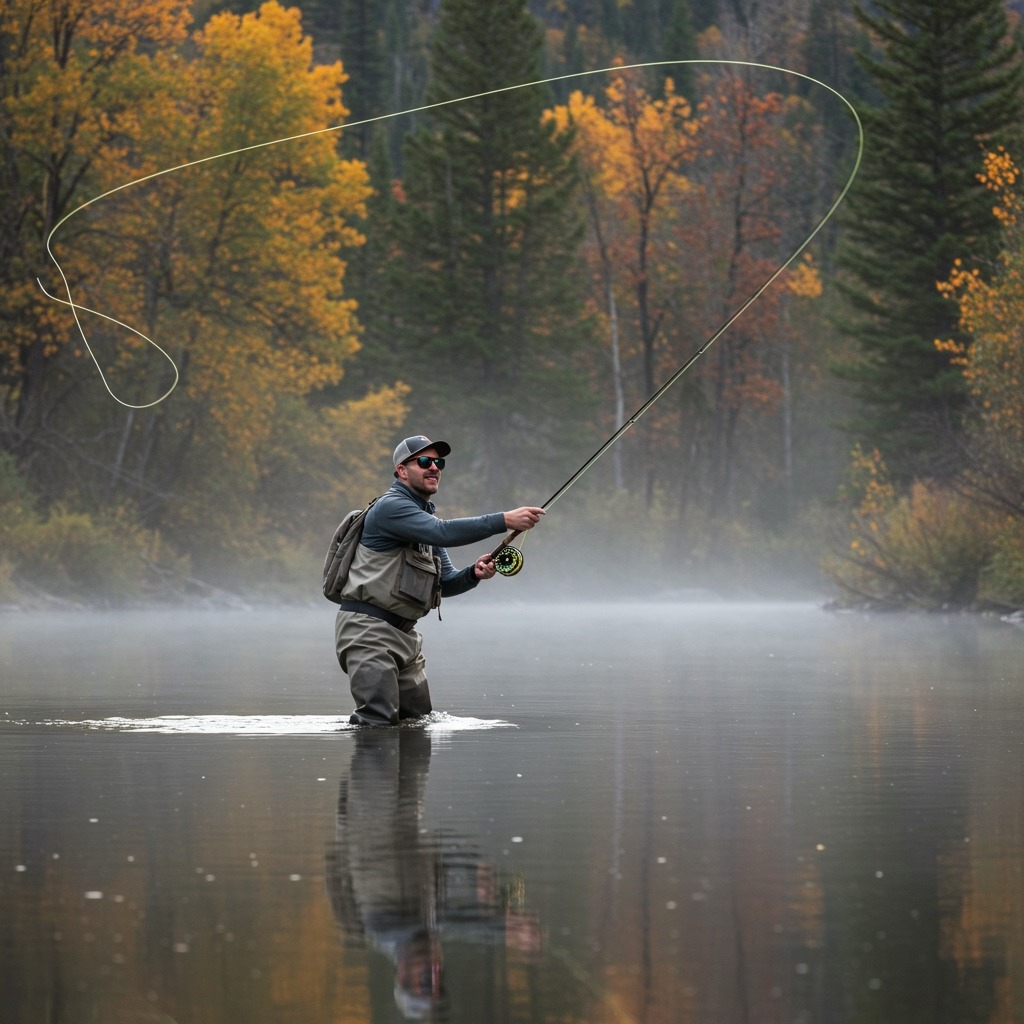There’s something uniquely captivating about fly fishing. It’s an art, a dance, a quiet communion with nature that many find deeply rewarding. But if you’re standing at the edge of the water, watching an experienced angler effortlessly cast a delicate line, it can feel intimidating. The gear looks complicated, the jargon is new, and the question looms: “Where do I even begin with a fly fishing setup?”
I get it. Every seasoned fly angler started exactly where you are – slightly overwhelmed, yet drawn to the elegance of the cast and the thrill of the take. My goal here is to strip away the complexity, break down the essential components of a fly fishing setup, and give you a clear, actionable roadmap to get started. You don’t need to be an expert to choose the right gear; you just need a straightforward guide. Let’s get you rigged up and ready to cast your first line. For a broader understanding, you might also find it helpful to explore fly fishing basics.

The Core Components of Your Fly Fishing Setup
Unlike traditional spin fishing, where a heavy lure carries your line, in fly fishing, the line carries the fly. This fundamental difference means your entire setup is built around presenting a nearly weightless imitation of an insect or baitfish. So, it’s not just a rod and reel; it’s a carefully balanced system.
Here are the essential pieces you’ll need:
- Fly Rod: Your casting tool.
- Fly Reel: Stores your line and helps manage running fish.
- Backing: Extra line on your reel for long runs.
- Fly Line: The weighted line that propels your fly.
- Leader: Tapered monofilament connecting fly line to tippet.
- Tippet: Fine line connecting leader to fly.
- Flies: The artificial imitations you cast.
Choosing Your Fly Rod: The Foundation

Your fly rod is the backbone of your fly fishing setup. It’s what you’ll hold, cast, and feel the fish through. Choosing the right one sets you up for success.
A. Rod Length & Weight
Fly rods are categorized by “weight,” which refers to their power and the weight of fly line they are designed to cast. This isn’t about the rod’s physical weight, but its casting power.
- Weight: This is the most crucial number. A 5-weight rod, for example, is generally considered the most versatile for trout fishing across various conditions.
- 1-3 weight: For very small fish (panfish, small brook trout), delicate presentations, small streams.
- 4-6 weight: The “all-around” category. 5-weight is king for most trout fishing. 6-weight is good for larger trout, smallmouth bass, or light saltwater. If you’re keen on targeting bass fishing with a fly rod, the higher end of this range or even a 7-weight might be your sweet spot.
- 7-9 weight: Good for larger bass, salmon, steelhead, light saltwater species.
- 10+ weight: For heavy saltwater fishing (tarpon, tuna) or very large freshwater species.
- Length: Standard lengths range from 7.5 to 10 feet.
- Shorter rods (7.5-8.5 ft): Great for small, brushy streams where precision and quick casts are key.
- Standard rods (9 ft): The most common and versatile length for all-around fly fishing. Offers good line control and casting distance.
- Longer rods (9.5-10 ft): Excellent for nymphing, roll casting, and handling large amounts of line, especially on bigger rivers or stillwaters.
- Matching to Target Species: Consider what you’ll primarily be fishing for. If it’s general trout fishing, a 9-foot, 5-weight rod is a fantastic starting point.
B. Rod Action
“Action” describes how much the rod bends when you cast.
- Fast Action: Bends mostly near the tip. Generates high line speed, great for long casts, windy conditions, and larger flies. Less forgiving for beginners.
- Medium Action: Bends through the top half or two-thirds of the rod. Versatile, offers good feel, distance, and accuracy. A great choice for most beginners.
- Slow Action: Bends deeply into the butt section. Best for delicate presentations, short casts, and small streams. Very forgiving and offers great feel, but struggles with distance.
For your first rod, a medium or medium-fast action rod will give you the best balance of feel, casting performance, and forgiveness as you learn.
C. Pieces
Fly rods typically come in 2, 3, 4, or even 6 pieces.
- 4-piece rods: The most common and convenient. They pack down small, making them easy to transport in a car or even carry on a plane. Excellent for travel.
- 2-piece rods: Offer a slightly smoother casting action but are less portable.
Selecting Your Fly Reel: The Line Holder
Your fly reel isn’t primarily for fighting fish like a spinning reel, but rather for holding your line and balancing your rod. However, a good drag system is crucial when a big fish decides to run!
A. Matching the Rod
Always match your reel’s weight rating to your rod’s weight rating. A 5-weight rod needs a reel designed for a 5-weight line. This ensures proper balance and performance.
B. Arbor Size
- Large Arbor: Has a larger diameter spool. This means faster line retrieval (you pick up more line with each crank) and less “memory” in your fly line, which helps reduce coils. Highly recommended for most situations.
- Standard Arbor: Smaller diameter spool. Slower retrieve, more line memory. Generally less preferred now.
C. Drag System
The drag system applies resistance to the line, allowing you to tire out a fish without breaking your tippet.
- Disc Drag: Modern, smooth, and powerful. Excellent for fighting larger fish that make strong runs.
- Click-and-Pawl: Simpler, lighter, and more traditional. Offers less stopping power but provides an audible “click” when line is pulled, which some anglers prefer. Best for smaller fish.
For your first fly fishing setup, a large arbor reel with a smooth disc drag will serve you well for a variety of fish and situations.

The Line System: More Than Just a String
This is where fly fishing truly differentiates itself. You don’t cast a weighted lure; you cast the weight of the fly line itself. This system, from backing to fly, is designed for seamless power transfer and stealthy presentation.
A. Backing
- Purpose: Backing is the thin, braided line that goes onto your reel first, before your fly line. It serves two purposes: to fill the reel spool (so your fly line doesn’t coil tightly and develop memory) and to provide extra line in case a large fish makes a long, powerful run.
- Material: Most commonly made of Dacron, a strong, low-stretch synthetic fiber.
- Connection: Securely tie one end to your reel’s arbor and the other to your fly line.
B. Fly Line
This is the workhorse of your casting.
- Purpose: Unlike traditional fishing lines, fly line is specifically weighted to provide the mass needed to load your fly rod and cast your fly forward.
- Types:
- Weight Forward (WF): The most popular type for general use. It has a heavier, tapered section at the front that helps load the rod for easier casting and distance, followed by a thinner running line.
- Double Taper (DT): Tapered on both ends, allowing you to reverse the line when one end wears out, extending its life. Best for delicate presentations at shorter distances.
- Floating vs. Sinking: Most beginner lines are floating. Sinking lines are for getting flies deep quickly.
- Matching to Rod Weight: Your fly line must match your rod’s weight rating (e.g., a 5-weight rod uses a 5-weight line). This is critical for proper casting. For more specific details on line types, including different types of fishing rods.
C. Leader
- Purpose: The leader is a tapered piece of monofilament or fluorocarbon that connects your thick fly line to the much finer tippet. Its tapered design helps transfer casting energy smoothly from the heavy fly line to the delicate fly, ensuring a natural presentation and preventing the fly from “splashing” down.
- Length and Material: Leaders come in various lengths (typically 7.5 to 12 feet) and materials. Nylon is common, while fluorocarbon is denser and less visible underwater, making it great for wary fish.
- Connection: You’ll connect the butt end of the leader to the end of your fly line. Many fly lines have a small welded loop at the end for an easy loop-to-loop connection.
D. Tippet
- Purpose: The tippet is the final, finest section of line that attaches directly to your fly. It extends the life of your leader, allows you to change flies without shortening your main leader, and provides a nearly invisible connection to the fly.
- X-Rating System: Tippet size is denoted by an “X” rating (e.g., 5X, 6X). A higher X number means a finer, weaker line.
- 0X (thickest) to 8X (thinnest).
- Generally, match your tippet size to your fly size. Larger flies (e.g., big streamers) use heavier tippet (0X-3X), while tiny flies (e.g., small dry flies) require very fine tippet (6X-8X) for delicate presentations.
- Importance: A good tippet is crucial for stealth and getting a natural drift from your fly.
Assembling Your Fly Fishing Setup: Step-by-Step
Putting it all together for the first time can seem like a puzzle, but it’s straightforward.
A. Attach Reel to Rod
- Align the reel foot with the reel seat on your rod.
- Tighten the locking rings (usually two) on the reel seat to secure the reel firmly in place.
B. Spool Backing
- Tie the arbor knot (or a simple overhand knot followed by a slip knot) to the arbor (the core) of your reel.
- Wind the backing onto the reel spool evenly and tightly. You’ll typically want to fill about 1/4 to 1/3 of the spool with backing.
C. Connect Fly Line to Backing
- Use a strong, reliable knot like an Albright knot or a nail knot to connect the backing to the butt end of your fly line. These knots are designed to be strong and smooth, preventing snags.
- Once connected, spool the entire fly line onto the reel, keeping it tight and even. Your reel should now be fairly full, but with enough space for the leader and tippet to not rub the reel frame.
D. Attach Leader to Fly Line
- The easiest way is using a loop-to-loop connection. Most modern fly lines have a welded loop at the end. Your leader will also likely have a loop.
- Simply pass the leader’s loop through the fly line’s loop, then pass the rest of the leader (including the tippet end) through its own loop. Pull tight to create a secure, smooth connection. If no loop, you can use a nail knot.
E. Add Tippet to Leader
- The tippet is attached to the finer end of your tapered leader. Common knots include the Surgeon’s knot or a blood knot. Both are strong and create a smooth connection.
- You’ll often add new sections of tippet as you change flies or if your tippet gets nicked.
F. Tie on a Fly
- This is the moment of truth! Choose your fly and tie it to the end of your tippet. The most common and reliable knot for this is the Improved Clinch Knot. It’s strong and relatively easy to learn. You can also explore options for the strongest fishing knot for ultimate security.
Essential Accessories & Beyond the Basics
While the rod, reel, and line are your core setup, a few key accessories will make your time on the water much more comfortable and productive.
A. Waders & Boots
- Waders: These waterproof pants (or overalls) allow you to stand in the water, getting closer to fish without getting wet. They come in breathable and neoprene versions.
- Wading Boots: Worn over waders, these provide grip on slippery river bottoms. Match them to your waders. Investing in good quality waders and boots will dramatically improve your fishing experience, especially for fly fishing vs regular fishing in diverse environments.
B. Net
A landing net (often with a rubberized mesh to protect fish) is essential for safely landing fish, especially if you plan to practice catch and release. It minimizes stress on the fish and makes unhooking easier.
C. Nippers & Hemostats
These are your indispensable tools.
- Nippers: Small clippers for cleanly cutting line and tippet.
- Hemostats (or Forceps): Small locking pliers used for easily removing flies from a fish’s mouth without causing harm.
D. Fly Box & Flies
You’ll need a selection of flies appropriate for the fish and conditions you expect. A good fly box will keep them organized and protected. Start with a few general-purpose flies (e.g., dry flies, nymphs, streamers) and expand as you learn.
E. Vest or Pack
A fly fishing vest, chest pack, or sling pack allows you to carry all your essential tools, fly boxes, and other small items within easy reach while you’re fishing.
F. Polarized Sunglasses & Hat
- Polarized Sunglasses: Crucial! They cut glare, allowing you to see into the water to spot fish and obstructions. They also protect your eyes from stray hooks.
- Hat: Provides sun protection and an extra layer of eye protection.
G. Learning to Cast
Once your gear is assembled, the next step is learning to cast. Fly casting is a unique skill that takes practice. Many fly shops offer beginner lessons, which can dramatically accelerate your learning curve. Don’t get frustrated; focus on smooth, controlled movements.
Getting Started: Your First Cast & Beyond

The world of fly fishing is vast and rewarding. Don’t feel pressured to buy the most expensive gear or master every technique immediately. The most important thing is to just start.
- Keep it Simple: For your initial fly fishing setup, focus on a versatile rod (like a 9-foot, 5-weight) and a basic selection of flies. You can always expand your arsenal later.
- Visit Your Local Fly Shop: These shops are goldmines of information. The staff are usually passionate anglers eager to help beginners. They can recommend specific gear for your local waters and even give you tips on where to go.
- Practice Makes Perfect: Spend time in your backyard or a local park simply casting to get a feel for the rod and line. The more comfortable you are with your casting, the more enjoyable your time on the water will be.
- Embrace the Journey: Fly fishing is a lifelong pursuit of learning. Each outing teaches you something new about fish, water, and yourself. So, rig up your first fly fishing setup, head to the water, and prepare for an incredible adventure.
FAQ: Your Fly Fishing Setup Questions Answered
What’s the best fly fishing setup for beginners?
A 9-foot, 5-weight, medium-fast action fly rod paired with a matching large arbor reel and a weight-forward floating fly line is widely considered the best all-around beginner setup. It’s versatile for most freshwater applications, especially trout.
Can I use a spinning reel with a fly rod?
No, a fly rod is designed to cast fly line, which is much heavier and thicker than traditional monofilament or braided spinning line. A spinning reel and line will not properly load a fly rod, making it impossible to cast effectively. Fly rods and spinning rods are fundamentally different tools.
How often should I replace my fly line?
With regular use and proper cleaning, a good quality fly line can last 2-5 years. Signs it needs replacement include cracking, stickiness, excessive memory (coiling), or loss of its slick coating which reduces casting distance.
What’s the difference between leader and tippet?
The leader is a tapered section of line (thick at the butt end, thin at the tip) that connects your fly line to the tippet. The tippet is a fine, untapered section of line that connects directly to your fly. Tippet is typically replaced frequently as flies are changed or if it gets nicked, preserving the longer, more expensive leader.
Do I need waders to fly fish?
Not always, but they are highly recommended for most river and stream fishing. Waders allow you to comfortably enter the water, access more fishing spots, and maintain a better casting position. For stillwater or bank fishing, you might not need them.
